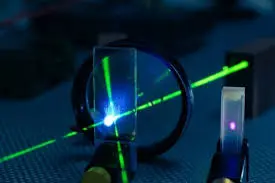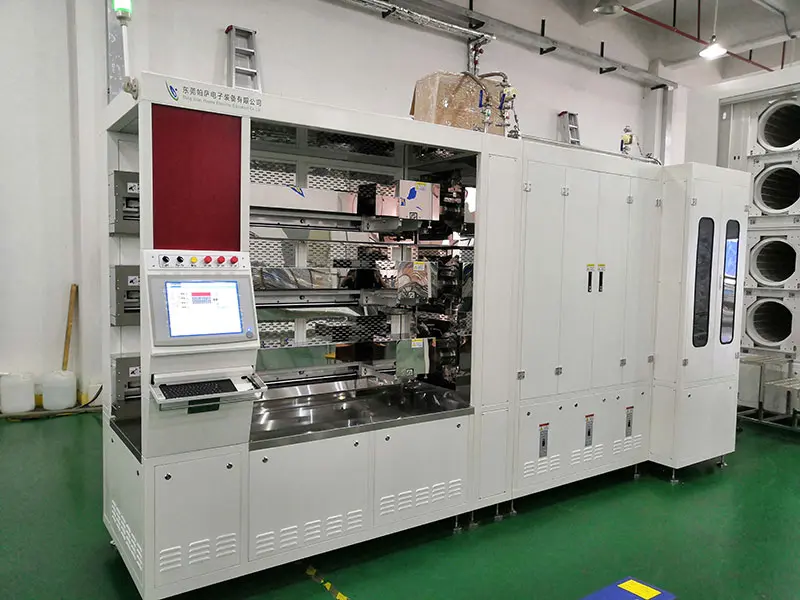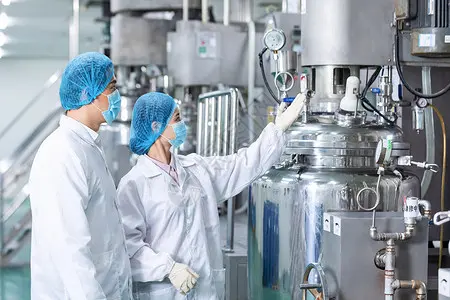Our quartz glass discs are precision-engineered components crafted from high-purity fused silica, renowned for their exceptional optical clarity and UV transmission. These robust discs exhibit superior thermal shock resistance, excellent chemical inertness, and a remarkably low coefficient of thermal expansion, making them ideal for extreme environments. With outstanding electrical insulation properties, our quartz discs are essential for critical applications in optics, semiconductor fabrication, and various high-temperature laboratory equipment. We offer a wide range of standard diameters and thicknesses to meet precise technical specifications.
| Diameter | Thickness |
|---|---|
| 3mm | 1mm |
| 4mm | 1mm |
| 5mm | 1mm |
| 6mm | 1mm |
| 7mm | 1mm |
| 8mm | 1mm |
| 8mm | 2mm |
| 9mm | 1mm |
| 10mm | 0.5mm |
| 10mm | 1mm |
| 10mm | 2mm |
| 11mm | 1mm |
| 12mm | 1mm |
| 15mm | 0.5mm |
| 15mm | 1mm |
| 15mm | 2mm |
| 16mm | 1mm |
| 18mm | 1mm |
| 20mm | 0.5mm |
| 20mm | 1mm |
| 20mm | 2mm |
| 20mm | 3mm |
| 22mm | 1mm |
| 25mm | 0.5mm |
| 25mm | 1mm |
| 25mm | 2mm |
| 25mm | 3mm |
| 25mm | 5mm |
| 25mm | 8mm |
| 30mm | 0.5mm |
| 30mm | 1mm |
| 30mm | 2mm |
| 30mm | 3mm |
| 30mm | 4mm |
| 30mm | 5mm |
| 35mm | 1mm |
| 35mm | 2mm |
| 35mm | 3mm |
| 35mm | 5mm |
| 40mm | 0.5mm |
| 40mm | 1mm |
| 40mm | 1.5mm |
| 40mm | 2mm |
| 40mm | 3mm |
| 40mm | 4mm |
| 40mm | 5mm |
| 45mm | 1mm |
| 45mm | 2mm |
| 45mm | 3mm |
| 50mm | 0.5mm |
| 50mm | 1mm |
| 50mm | 2mm |
| 50mm | 3mm |
| 50mm | 4mm |
| 50mm | 5mm |
| 50mm | 8mm |
| 50mm | 10mm |
| 55mm | 1mm |
| 55mm | 3mm |
| 55mm | 5mm |
| 60mm | 1mm |
| 60mm | 2mm |
| 60mm | 3mm |
| 60mm | 5mm |
| 70mm | 2mm |
| 70mm | 3mm |
| 70mm | 5mm |
| 80mm | 2mm |
| 80mm | 3mm |
| 80mm | 5mm |
| 80mm | 10mm |
| 90mm | 2mm |
| 90mm | 3mm |
| 90mm | 5mm |
| 100mm | 0.5mm |
| 100mm | 1mm |
| 100mm | 2mm |
| 100mm | 3mm |
| 100mm | 5mm |
| 100mm | 10mm |
| 150mm | 2mm |
| 150mm | 3mm |
| 150mm | 5mm |
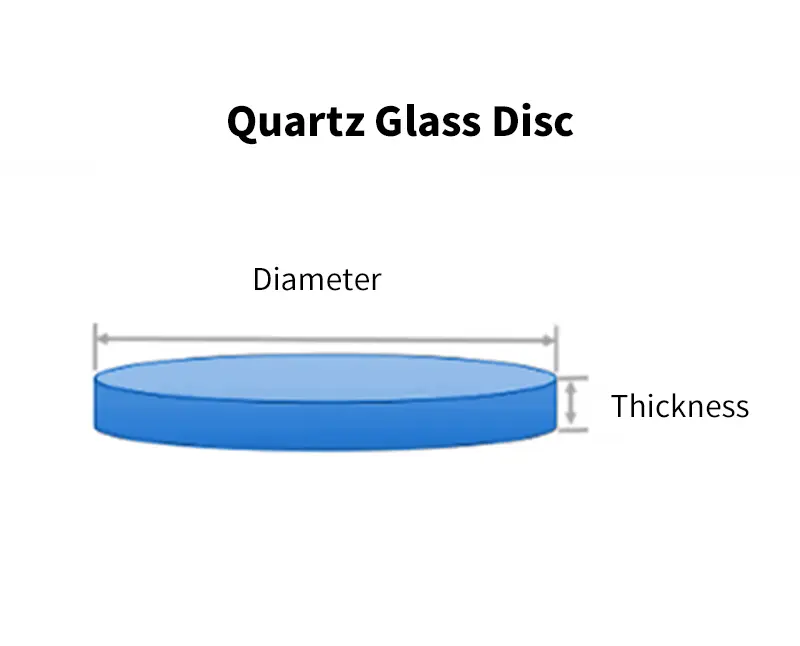
- ayment method: By wire transfer or advance payment, depending on the quantity of the order.
- Delivery time: According to the order quantity.
- Transportation method: Sea freight or air freight, depending on the customer.
Remarks:
To confirm the order, The following parameters need to be provided: ① Square: length, width, thickness ② Circle: diameter, thickness ③ Accuracy ④ Quantity
| Property Content | Property Values |
|---|---|
| SiO2 | 99.99% |
| Density | 2.2×10³ kg/cm³ |
| Hardness | 5.5 - 6.5 Mohs' Scale 570 KHN 100 |
| Tensile Strength | 4.8×10⁷ Pa (N/mm2) (7000 psi) |
| Compression Strength | >1.1×10⁹ Pa (160,000 psi) |
| Coefficient of Thermal Expansion | 5.5×10⁻⁷ cm/cm·°C (20°C-320°C) |
| Thermal Conductivity | 1.4 W/m·°C |
| Specific Heat | 670 J/kg·°C |
| Softening Point | 1730°C (3146°F) |
| Annealing Point | 1210°C (2210°F) |
| Strain Point | 1120°C (2048°F) |
| Work Temperature | 1200°C (2192°F) |
| Electrical Resistivity | 7×10⁷ ohm cm (350°C) |
| Size | Customized |
| Logo | Customized Logo Accept |
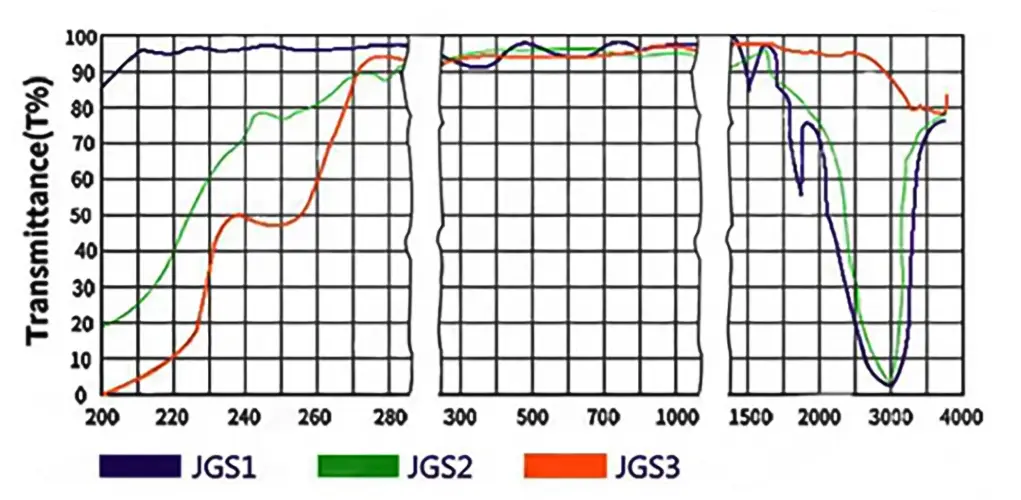
JGS1
Commonly known as UV-grade fused silica, this material exhibits exceptionally low dispersion and very high transmittance in the ultraviolet (UV) spectral range.
JGS2
Similar to JGS1, but may have variations in specific performance parameters such as transmittance and thermal expansion coefficient, depending on the manufacturer’s standards.
JGS3
Typically used in applications requiring higher purity or specialized performance characteristics. Specific performance parameters can vary based on the manufacturer.
High Heat Resistance
Quartz glass softens around 1730°C, can be used continuously at 1100°C, and briefly up to 1450°C.
Low Thermal Expansion
Quartz discs have a very low thermal expansion, resisting cracking from quick temperature changes.
Corrosion Resistance
Quartz glass resists most acids, except hydrofluoric acid, and has acid resistance 30 times greater than ceramics and 150 times greater than stainless steel.
Excellent Light Transmission
Quartz discs transmit light well across the UV to IR range, with over 93% visible light transmission and over 80% maximum UV transmission.
Application Scenario
A low thermal expansion coefficient means that quartz discs/wafers maintain dimensional stability under temperature changes, which is crucial for high-technology applications requiring precise control.
Quartz discs/wafers have good light transmission, especially in the ultraviolet to infrared spectral range, making them ideal materials for optical applications.
Quartz discs are excellent electrical insulators, which makes them very useful in the electronics and semiconductor industries
Frequently asked questions
We specialize in the end-to-end manufacturing of high-purity quartz glass components. Our core product lines include:
Quartz Tubing & Rods: A wide range of diameters and specifications.
Quartz Plates & Discs: Precision-cut and polished for optical and industrial use.
Quartz Labware: A full suite of standard and custom glassware, including beakers, flasks, and boats.
Semiconductor-Grade Quartz: High-purity components like process tubes and carriers for semiconductor fabrication.
Custom Fabricated Components: We can produce complex parts tailored to your unique designs and specifications.
Yes. Custom fabrication is at the core of our business. With over a decade of specialized experience, we partner with companies to provide expert OEM/ODM services. Our capabilities include welding, grinding, drilling, polishing, bending, and other precision processing techniques to create components that meet your exact requirements.
Quality is paramount in our manufacturing process. We are an ISO 9001:2015 certified manufacturer, ensuring that our processes meet international quality management standards.Our products also undergo rigorous SGS testing for purity and performance. We use high-purity raw materials (up to 99.998% SiO2) to produce fused quartz and fused silica products with exceptional thermal stability, high-temperature resistance, and chemical inertness.
We've streamlined our process to be as efficient as possible:
Submit Your RFQ: Send us your technical drawings, specifications, and requirements via our website contact form or email.
Rapid Response: You can expect an initial response within minutes and detailed communication within half an hour.
Design & Proposal: We will deliver a detailed design proposal and a competitive quote within 24 hours.
Prototyping & Production: Upon approval, we move swiftly from prototyping to full-scale production to meet your deadlines.
Partnering with Aoxin Quartz offers several key advantages:
Proven Expertise: With 10+ years in the industry, we have the technical knowledge to tackle complex challenges.
One-Stop Solution: We manage the entire production process, from sourcing high-purity raw materials to fabricating and finishing complex components.
Competitive Value: Located in a major quartz production hub, we leverage an efficient supply chain and advanced manufacturing to offer exceptional quality at a competitive price point.
Dedicated Partnership: Over 90% of our clients become long-term partners. We are committed to your success through responsive service, reliable quality, and innovative solutions.


